



















|
 |
|
 |

Here you can see which units you will fight against and also which units you can recruit from Anatolia, Galatia, the Caucasus and Arabia. And also from the Fertile Crescent.
Anatolikoi Phyletai (Anatolian Hillmen)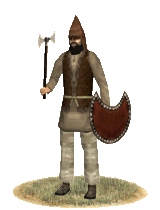 These troops are armed with a large axe, with a double, half-moon shaped blade called a Bipennis. They also use a wooden, crescent-shaped shield similar to the old Greek Pelte. They favour bright clothing and often paint their shields in garish colours. Their charges are dangerous for most enemies and even the stoutest armour will suffer from a blow of the weapons they wield. However, being lightly protected themselves protracted fighting will see their casualties mounting. These troops are armed with a large axe, with a double, half-moon shaped blade called a Bipennis. They also use a wooden, crescent-shaped shield similar to the old Greek Pelte. They favour bright clothing and often paint their shields in garish colours. Their charges are dangerous for most enemies and even the stoutest armour will suffer from a blow of the weapons they wield. However, being lightly protected themselves protracted fighting will see their casualties mounting.
Historically, the Anatolian highlands always featured axes in their warfare. The axe was the characteristic weapon of the infantry recruited there and they excelled in its use. The more civilized nations often suffered from attacks by the mountain tribes of Anatolia. Wise kings have put this to use, and these men are recruited from the native tribesmen who sell their warrior skills to the highest bidder.
Katpatuka Zanteush (Cappadoccian Hillmen)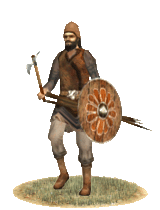 These fierce tribesmen come from the ancient land of Kappadokia, the Hittite, Katpatuka 'land of the beautiful horses'. The tribal warriors raised in the mountains of Kappadokia know the terrain and are well equipped, with javelin and axe, for mountain warfare. They will not do as well away from these heights, as they lack the heavier armour of the Greek infantry. Their axes and javelins will allow them to give a good account of themselves but heavy melee should be avoided. These fierce tribesmen come from the ancient land of Kappadokia, the Hittite, Katpatuka 'land of the beautiful horses'. The tribal warriors raised in the mountains of Kappadokia know the terrain and are well equipped, with javelin and axe, for mountain warfare. They will not do as well away from these heights, as they lack the heavier armour of the Greek infantry. Their axes and javelins will allow them to give a good account of themselves but heavy melee should be avoided.
Historically, while some of the tribes living in the mountains were hostile towards the Greeks, others cultivated very close relationships with them. It is from these mountain warriors the Tibareni and Chaldaei tribesmen, the Mossynoecians, Makrones and other tribes residing in the eastern part of Northern Anatolia, that the skirmishers of Pontos are recruited. the terrain of Pontos is well suited to the style of warfare these men are practiced at. The Pontic Alps stand as a wall between the interior plateau and the rich, narrow plain bordering the sea. These tribes ward the mountain approaches and the kings of Pontos know well the value of such friendship. Xenophon too found such frienship of great value in his passage of these regions. Many of these mountains are thoroughly impassable and altogether precipitous, and there are extensive areas devoid of human habitation, only plunging ravines from which it is impossible to climb out, forested heights and impassable chasms.
Misthophoroi Uazali (Mercenary Karian Warband)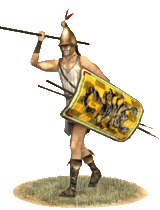 The Uazali are warbands of soldiers from the peoples of the southern coast of Mikra Asia: the Karians, Lykians, Pamphylians, and Pisidians. These warlike peoples have long traditions of military service abroad, and of nearly constant local warfare between the small cities and towns separated by the towering heights of the western Taurus. These Uazali are skilled mountain fighters. Their name comes from the Lykian tongue, and means "Warriors," and is similar also to the words used by the other peoples along the southern coast of Mikra Asia, all of whose languages derived primarily from the Hittite tongue. The Uazali carry a solid rectangular shield slung over the shoulder to ease the burden on the arms, emblazoned with signs of their peoples, and wear a solid Phrygian helm, a common form of protection among those in Asia who could afford such things. For weapons, they carry several javelins and a lengthened xiphos sword, which became a popular weapon in Mikra Asia, both as a result of the Iphikratid reforms, and out of experience fighting the Galatai, with their longswords. Their shields and helmets provide them a great deal of protection compared to most other skirmishing units, and their ferocity in melee surpasses most of their peers. The Uazali are warbands of soldiers from the peoples of the southern coast of Mikra Asia: the Karians, Lykians, Pamphylians, and Pisidians. These warlike peoples have long traditions of military service abroad, and of nearly constant local warfare between the small cities and towns separated by the towering heights of the western Taurus. These Uazali are skilled mountain fighters. Their name comes from the Lykian tongue, and means "Warriors," and is similar also to the words used by the other peoples along the southern coast of Mikra Asia, all of whose languages derived primarily from the Hittite tongue. The Uazali carry a solid rectangular shield slung over the shoulder to ease the burden on the arms, emblazoned with signs of their peoples, and wear a solid Phrygian helm, a common form of protection among those in Asia who could afford such things. For weapons, they carry several javelins and a lengthened xiphos sword, which became a popular weapon in Mikra Asia, both as a result of the Iphikratid reforms, and out of experience fighting the Galatai, with their longswords. Their shields and helmets provide them a great deal of protection compared to most other skirmishing units, and their ferocity in melee surpasses most of their peers.
Historically, many young men from Karia, Lykia, Pamphylia and Pisidia went overseas to serve as mercenaries, or were recruited in their native lands as militias and katoikoi for the successors. Many of the most Hellenized inhabitants joined the ranks of thureophoroi and other medium infantry units in other lands. Many others, however, stayed closer to their native infantry traditions, and served abroad as warrior bands, or as locally-recruited troops in their own lands. They were used to great effect in irregular mountain combat, but also distinguished themselves in assaults, and if they end up in the battle line in major pitched battle, a good commander will maximize their skirmishing and melee abilities by using them in a flanking, ambushing, or screening role if at all possible.
Galatikoi Kluddolon (Galatian Shortswordsmen)
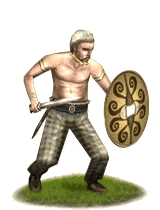 The Kluddolon (Klud-oh-lon; "Sword Bearers") make up a light levy of Galatian warriors. They are young, and fairly unreliable due to this. However, they part of the common levies that accompany Galatian chiefs; as such, mercenary Galatians would be accompanied by many men of this class of warrior. They are used as light, mobile warriors to hit in short strikes, or used on flanks. They were also historically used to break phalanxes. The Kluddolon (Klud-oh-lon; "Sword Bearers") make up a light levy of Galatian warriors. They are young, and fairly unreliable due to this. However, they part of the common levies that accompany Galatian chiefs; as such, mercenary Galatians would be accompanied by many men of this class of warrior. They are used as light, mobile warriors to hit in short strikes, or used on flanks. They were also historically used to break phalanxes.
Historically, Galatian mercenaries were very popular with any who could afford to hire them, and were also reputed as maruaders. The shortswordsmen were a valuable part of a Galatian force; they would be used to get under a phalanx and gut it before heavier soldiers would enter the breach and cut down the spearmen from within. As such, the seemingly very light, weak infantry could be a very feared part of a Galatian force. Their name is a from the Galatian Celtic; a form of Gallic with very overt Greek influences.
Galatikoi Kuarothoroi (Galatian Heavy Spearmen)
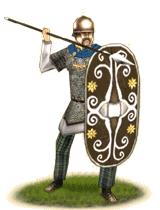 The Kuarothoroi were superb Galatian warriors that often fought for Pontos and Pergamon. Kuarothoroi are elite heavy spearmen recruited from among the Galatian tribes near the Pontic border. They form the vanguard of the shock infantry of both nations, and are well able to give a good account of themselves. They are armed and armoured to the teeth and are well able to serve as a disciplined and nearly fanatic shock infantry. They carry long spears and wield large shields which make them ideal flankers in the situation that they are deployed against phalanx units. Other than this, Kuarothoroi are well able to attack and defend against various types of soldiers, putting them among the most versatile heavy infantry. They are particularly deadly against cavalry. A smart commander will place these armoured troops where the battle is likely to be the hardest fought. The Kuarothoroi were superb Galatian warriors that often fought for Pontos and Pergamon. Kuarothoroi are elite heavy spearmen recruited from among the Galatian tribes near the Pontic border. They form the vanguard of the shock infantry of both nations, and are well able to give a good account of themselves. They are armed and armoured to the teeth and are well able to serve as a disciplined and nearly fanatic shock infantry. They carry long spears and wield large shields which make them ideal flankers in the situation that they are deployed against phalanx units. Other than this, Kuarothoroi are well able to attack and defend against various types of soldiers, putting them among the most versatile heavy infantry. They are particularly deadly against cavalry. A smart commander will place these armoured troops where the battle is likely to be the hardest fought.
Historically, Kuarothoroi were among the most 'Hellenized' of the Galatian warrior class and many took Greek or Persian wives and settled in new homelands on rich estates won by their superb military service to either nation. Their name derived from the Greek name kouros-kouretes which means young men of fighting age and therefore warriors.
Galatikoi Lavotuxri (Galatian Heavy Cavalry)
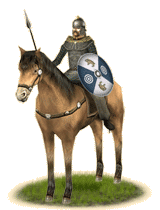 The Lavotuxri are cavalrymen, made up of young Galatian nobles and aristocrats of military age. They fight in the same manner as Gallic cavalry in Western Europe, although they wear tunics of brighter colors to better stand the Anatolian heat. They are equipped with Gallic-style chain mail, Gallic helmets and large round shields. They also carry Celtic longswords and spears. Their horses, if not stolen are imported from the steppes north the Pontos Euxine, Armenia or even Media. The Lavotuxri are good medium cavalry, well able to do their part on the battlefield as long as they are used in that role. The Lavotuxri are cavalrymen, made up of young Galatian nobles and aristocrats of military age. They fight in the same manner as Gallic cavalry in Western Europe, although they wear tunics of brighter colors to better stand the Anatolian heat. They are equipped with Gallic-style chain mail, Gallic helmets and large round shields. They also carry Celtic longswords and spears. Their horses, if not stolen are imported from the steppes north the Pontos Euxine, Armenia or even Media. The Lavotuxri are good medium cavalry, well able to do their part on the battlefield as long as they are used in that role.
Historically, the Lavotuxri were skilled cavalrymen and could often be found in service to the Successor states, but were most prominent in the armies of Pergamon and Pontos. The wars of the Hellenistic monarchies provided ample opportunity for the Galatians to seek their fortunes as mercenaries, and they were highly sought after. From the time they crossed into Anatolia until the battle of Actium, Galatians were involved in almost every major battle and war in the eastern Mediterranean.
Galatikoi Tindanotae
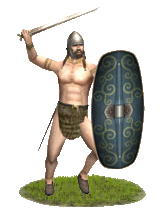 The Tindanotae (Ten-dan-ot-ay; "Wild/Mad Men") are the product of the dying tradition of naked Celtic warriors. They are fierce, brave to the point of insanity, and able to break even well disciplined formations with a furious charge, preceded by javelins. The Tindanotae can stand well in a melee, and their appearance is known to shake even the most experienced warriors. It is not unusual for Tindanotae to stand and fight until they are all dead, or their enemies run off, killed, or captured. The Tindanotae (Ten-dan-ot-ay; "Wild/Mad Men") are the product of the dying tradition of naked Celtic warriors. They are fierce, brave to the point of insanity, and able to break even well disciplined formations with a furious charge, preceded by javelins. The Tindanotae can stand well in a melee, and their appearance is known to shake even the most experienced warriors. It is not unusual for Tindanotae to stand and fight until they are all dead, or their enemies run off, killed, or captured.
Historically, Galatia still had warriors who fought nude. These warriors were generally older, more experienced fighters, with fanatical or murderous attitudes. Many may well have been truly insane or psychotic. It was not unusual for the Tindanotae to be religious fanatics. They favored devotion to Heracles, or traditional Gallic war gods like Teutatis; later, in severely reduced numbers due to Roman domination, they would be generally Christian fanatics. It was not unusual for the Tindotae to carve a name or symbol on their own body representing their chosen god. This manner of self mutilation was also left over from bygone days of Gaul, when men would scar themselves to show their strength.
Kovkasi Lernain Netadzik (Caucasian Archers)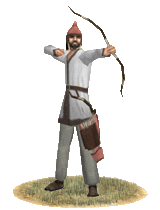 In the mountains of the Caucasus and the highlands below the people have lived a long and healthy existence, sustained as they are from the surplus fruits of the fertile valleys and rich mineral seams. But their history has also seen strife, for their mountain kingdoms are highly prized by those of the fertile crescent below. Not only the spear and sling, but also the bow are used by these hardy mountain-men, who protect their land from foreign looking for dominion and even rival kingdoms within the Caucasus region who seek to expand their lands. Lightly equipped, these archers are used to the trying terrain of the Caucasus and their training is more for light skirmishes than heavy battle upon an open field. Yet though they may find themselves fighting outside of home territory on the flat plains of the lands to the south, they should not be underestimated. Their bows are well made, learnt from the steppe nomads beyond the northern mountains and the Persians who conquered them later. They wear little in the way of armour, a leather jerkin over a warm woolen tunic, which offers little in the way of protection. Other than the bow, they carry a short knife, or other such simple melee weapon as they are not trained for and not meant for combat at close-quarters. In the mountains of the Caucasus and the highlands below the people have lived a long and healthy existence, sustained as they are from the surplus fruits of the fertile valleys and rich mineral seams. But their history has also seen strife, for their mountain kingdoms are highly prized by those of the fertile crescent below. Not only the spear and sling, but also the bow are used by these hardy mountain-men, who protect their land from foreign looking for dominion and even rival kingdoms within the Caucasus region who seek to expand their lands. Lightly equipped, these archers are used to the trying terrain of the Caucasus and their training is more for light skirmishes than heavy battle upon an open field. Yet though they may find themselves fighting outside of home territory on the flat plains of the lands to the south, they should not be underestimated. Their bows are well made, learnt from the steppe nomads beyond the northern mountains and the Persians who conquered them later. They wear little in the way of armour, a leather jerkin over a warm woolen tunic, which offers little in the way of protection. Other than the bow, they carry a short knife, or other such simple melee weapon as they are not trained for and not meant for combat at close-quarters.
Historically the Caucasus region was not well known for its archery, it was the cavalry that they were famous for. However, they undoubtedly used the bow just as they used the sling and javelin. Xenophon was unlucky enough to find himself at the wrong end of worrying tactics of such a people, the Karduchi, who may have been the ancestors of the modern day Kurds, as he and his force battled through the Caucasus highlands to the southern shore of the Black Sea. Xenophon mentions that the bow the Karduchi used was the three cubits long, whilst the arrow was two cubits itself. Xenophon further reports that "When discharging the arrow, they draw the string by getting a purchase with the left foot planted forward on the lower end of the bow. The arrows pierced through shield and cuirass, and the Hellenes, when they got hold of them, used them as javelins, fitting them to their thongs." Powerful weapons indeed.
Kartvelebi Dashna-Mebrdzolebi (Georgian Medium Infantry)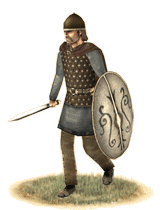 These Kartvelebi Dashna-Mebrdzolebi are fierce professional soldiers of the tribes who were born of Kartlos, the great hero of the Kartvelebi (Georgians). They are armed with javelins, a versatile and widely used weapon, a short sword and a Thureos shield, made popular in the Anatolia region with the coming of the Galatians. As true warriors they understand the need for protection and wear a studded-leather coat over a thick woollen tunic. Highly trained and experienced, these men are shock troops of the highest calibre; fierce and brave they are best used to break the enemy formation from the flanks or rear as their charge is fearsome. However, do not underestimate their ability to hold rank and withstand a charge themselves; truly these Dashna-Mebrdzolebi are versatile fighters. These Kartvelebi Dashna-Mebrdzolebi are fierce professional soldiers of the tribes who were born of Kartlos, the great hero of the Kartvelebi (Georgians). They are armed with javelins, a versatile and widely used weapon, a short sword and a Thureos shield, made popular in the Anatolia region with the coming of the Galatians. As true warriors they understand the need for protection and wear a studded-leather coat over a thick woollen tunic. Highly trained and experienced, these men are shock troops of the highest calibre; fierce and brave they are best used to break the enemy formation from the flanks or rear as their charge is fearsome. However, do not underestimate their ability to hold rank and withstand a charge themselves; truly these Dashna-Mebrdzolebi are versatile fighters.
Historically, life in the Caucasus Mountains bred a fierce people and the men of the Kartvelebi tribes - born of the loins of Kartlos, the great hero of old - were no exception. For centuries the Kartvelebi had warred amongst the competing tribes of the Caucasus and their rugged lifestyle, and the equal toughness of the terrain they inhabited, gradually honed them into a truly hardy people, well disposed to combat and harsh conditions. After being brought together beneath the dynasty of the Pharnavazian kings and they posed an increased threat to the neighbouring tribes and kingdoms of that region, particularly Hayasdan, their long standing enemy. Beneath the Pharnavazian dynasty Iberia survived as an independent kingdom until 93 BCE, when Arshak, a prince of Hayasdan, overthrew Pharnajom and established his own dynasty. Pharnajom’s son would a later take back his father’s throne in 32 BCE and the second Pharnavazian dynasty lasted well into the Common Era.
Hai Nizagamartik (Armenian Spearmen)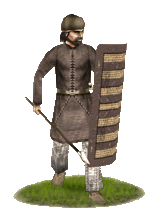 The people of Caucasus region have long been at war for the fertile valleys and rich seams of metal beneath the rock. The harsh climate and the simple way of life have been crucial in breeding a hardy and fierce people. The tribes who owe allegiance to Hayasdan, the cultural successor to the older Urartean kingdom, are no different and are themselves a fierce people. They are Haik - Armenians to the outside world - and descendants of the original Nairi tribes and the migrant Armina people: these tribes, most loyal to the idea of Hayasdan raise spearmen from amongst their most fearsome men to fight in the armies of the Hai Arkah (Armenian king). The people of Caucasus region have long been at war for the fertile valleys and rich seams of metal beneath the rock. The harsh climate and the simple way of life have been crucial in breeding a hardy and fierce people. The tribes who owe allegiance to Hayasdan, the cultural successor to the older Urartean kingdom, are no different and are themselves a fierce people. They are Haik - Armenians to the outside world - and descendants of the original Nairi tribes and the migrant Armina people: these tribes, most loyal to the idea of Hayasdan raise spearmen from amongst their most fearsome men to fight in the armies of the Hai Arkah (Armenian king).
Due to heavier Persian influences - in the Achaemenid days of the Persian Empire Armenia was a powerful and important Satrapy - these men carry light, but large and strong, wicker shields, which offer generous protection from the enemy missiles and makes for a stout wall when in formation. If used in conjunction with their iron-tipped spear, they present an unappealing target to both cavalry and infantry. These men have been trained well, and shouldn’t be considered as hastily raised farmers and herdsmen: they have been trained to keep in formation and not be hasty in their attacks. Yet still, do not mistake these men as equals to the Hellenic infantry of the plains below; they lack the level of discipline of the phalanx units of the Seleukids, and while they may not be untrained farmers nor are they professional soldiers and they should not be expected to stand against overwhelming odds.
Kavakaza Sparabara (Caucasian Spearmen)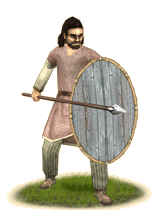 The Caucasus Range: fierce mountains breed a fierce people and these men, drawn from the tribes of the Caucasus, are fierce indeed! For centuries the tribes that inhabit these hostile climes have warred amongst the ominous and noble mountains, and this harsh lifestyle has bred a hardy people. The simple folk of the Caucasus region, men of farms and fields, livestock and grain, are grown into a world where knowledge of sling, bow, javelin and spear are as necessary as the written word is for the Hellenes. A sling will catch them a rabbit, a javelin or bow will keep predators from their flock, and a spear will protect them from their neighbour’s envious eyes. These life-skills, learnt amongst the mountains, make for hardy warriors, braver and more fearsome than the city-folk of the plains below. The Caucasus Range: fierce mountains breed a fierce people and these men, drawn from the tribes of the Caucasus, are fierce indeed! For centuries the tribes that inhabit these hostile climes have warred amongst the ominous and noble mountains, and this harsh lifestyle has bred a hardy people. The simple folk of the Caucasus region, men of farms and fields, livestock and grain, are grown into a world where knowledge of sling, bow, javelin and spear are as necessary as the written word is for the Hellenes. A sling will catch them a rabbit, a javelin or bow will keep predators from their flock, and a spear will protect them from their neighbour’s envious eyes. These life-skills, learnt amongst the mountains, make for hardy warriors, braver and more fearsome than the city-folk of the plains below.
These Caucasian Spearmen are armed with a simple spear - held underarm - and a Thureos shield, introduced into Anatolia during the Galatian invasions. They wear no armour, such a luxury cannot be afforded, and instead simply wear the clothes of normal, everyday use: a tunic tied at the waist and loose fitting trousers. When fighting they form a solid wall of shields, their spears a fearsome barrier against oncoming attack. However, these men are not disciplined, they have no formal training in warfare beyond what the most experienced warriors of a tribe can impart, and may break rank leaving gaps that the enemy can exploit. Yet, they do form the backbone of the armies that wage war beneath the shadows of the Caucasus Range, and - perhaps - beyond.
Srakir Martikner (Armenian Medium Infantry)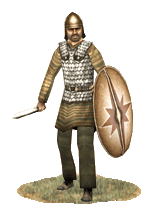 These men, seemingly 'armed in the Roman fashion' to the eyes of Roman witnesses, are highly regarded by all those they face in battle. These troopers are skilled swordsmen or Sooseramartik (soo-seh-ra-mar-teek) as the Armenians call them, who specialize in the frontal assault against spear and pike formations, so common to the ancient world. They use the distinctive bronze-faced oval thureos shield introduced by the Galatians following their invasion of Anatolia many years ago and are well armed with sword and javelin and wear iron scale corselets. Protected with their shields, they would throw their heavy javelins, before advancing to contact. These armoured guardsmen are well motivated and highly disciplined. These men, seemingly 'armed in the Roman fashion' to the eyes of Roman witnesses, are highly regarded by all those they face in battle. These troopers are skilled swordsmen or Sooseramartik (soo-seh-ra-mar-teek) as the Armenians call them, who specialize in the frontal assault against spear and pike formations, so common to the ancient world. They use the distinctive bronze-faced oval thureos shield introduced by the Galatians following their invasion of Anatolia many years ago and are well armed with sword and javelin and wear iron scale corselets. Protected with their shields, they would throw their heavy javelins, before advancing to contact. These armoured guardsmen are well motivated and highly disciplined.
Historically, Mardig swordsmen were drawn from those of the Azat lesser nobility unable or disinclined to go to war mounted. The equipment they used and their battlefield tactics, though quite likely evolved without any major Roman influence, appeared to Roman observers similar to their own practices and they recorded it so. In modern times, these comments would give rise to the largely misguided notion of "imitation legionaries".
Nizakahar Ayrudzi (Armenian Skirmisher Cavalry)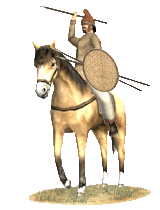 Ayrudzi, literally means "the horsemen". These light cavalry are well suited to the mountainous home of the Armenians. These are light cavalry, best used for a harassing role. Armed with a bundle of javelins and protected by a Taka shield, these horsemen have no armour, preferring to use speed to protect themselves. After they use up their javelins, they can close to fight with a spear, though they are really too lightly equipped to stand up to any save the lightest of troop types. While not as long ranged or as tough as Armenia’s nomadic neighbour’s, horse archers, they fill essentially the same role, and any Eastern general would certainly want to include them in their army. Ayrudzi, literally means "the horsemen". These light cavalry are well suited to the mountainous home of the Armenians. These are light cavalry, best used for a harassing role. Armed with a bundle of javelins and protected by a Taka shield, these horsemen have no armour, preferring to use speed to protect themselves. After they use up their javelins, they can close to fight with a spear, though they are really too lightly equipped to stand up to any save the lightest of troop types. While not as long ranged or as tough as Armenia’s nomadic neighbour’s, horse archers, they fill essentially the same role, and any Eastern general would certainly want to include them in their army.
Historically, Ayrudzi cavalry came from the poorer Azats (lesser nobles) and rich Ramiks (peasantry) of Armenia unable to afford better gear, but rich enough for mounted warfare, often a more prestigious service in Armenian armies.
Ioudaioi Taxeis (Jewish Spearmen)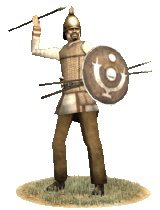 These Ioudaioi Taxeis have been recruited in the army for the purpose of providing reliable garrison troops, useful for policing borders and keeping the general population in line. They have been given somewhat outdated equipment consisting of a Phrygian helmet, a solid spear, javelins and a round shield. Though generally unimpressive, many of the soldiers supplement this equipment with armor purchased or manufactured on their own. This added body armor, combined with a good track record of loyalty and valor, make them a tough and reliable medium infantry force, capable of taking on much heavier opponents. This makes them excellent troops to fight off the occasional raids from desert peoples or hold off a more serious invasion until more professional reinforcements have arrived. These Ioudaioi Taxeis have been recruited in the army for the purpose of providing reliable garrison troops, useful for policing borders and keeping the general population in line. They have been given somewhat outdated equipment consisting of a Phrygian helmet, a solid spear, javelins and a round shield. Though generally unimpressive, many of the soldiers supplement this equipment with armor purchased or manufactured on their own. This added body armor, combined with a good track record of loyalty and valor, make them a tough and reliable medium infantry force, capable of taking on much heavier opponents. This makes them excellent troops to fight off the occasional raids from desert peoples or hold off a more serious invasion until more professional reinforcements have arrived.
The Ptolemaioi, who after the battle of Gaza gained a firm hold on Ioudaia, lacked the Hellenic manpower to firmly garrison all of Koile Syria as well as their possessions in Egypt and Hellas. To supplement their Hellenic forces, they began recruiting heavily from a few local, warlike populations. In Koile Syria, these were the Ioudaioi and Samareitai, many of whom fought in the small field armies used by the Ptolemaioi to police the borders against Arab raids or Seleukid invasions. Armed as medium infantry, they could expect a shield, helmet, and spear from their employers, and many added light armor of their own, manufactured by their families. They proved more valuable soldiers than the Ptolemaioi had expected, well able to defeat many comparable opponents in either skirmishes or close quarters battle, and many eventually received a full-size kleros in Aigyptos. With the advent of Seleukid rule in Ioudaia, after the battle of Panion, the Ioudaioi contingents did not fall out of favor. In fact, the Seleukid monarchs had been levying outlying Ioudaian populations to serve in garrison duty all over their empire, from Lydia to India, and they only increased their use of Ioudaioi after seizing the province from the Ptolemaioi. This policy helped the Seleukids slow the deterioration of their farther territories, but also led to more disastrous consequences--a more able enemy--when the Ioudaioi eventually revolted from Seleukid rule. Even after Epiphanes' wars against them, and the atrocities committed on both sides, the Ioudaioi remained common contingents in late Seleukid armies.
Toxotai Syriakoi (Syrian Archers)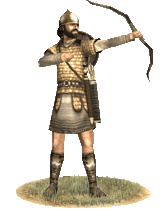 Toxotai Syriakoi are armed with composite bows, which make them a class above most archers. They have long ranged bows and carry a good amount of arrows, and know how to use these bows through centuries of tradition in their homelands and a constant need to supplement their poor diets with meat. They are good soldiers, but suffer from a morale problem since they are a subjugated people. They can be expected to use their arrows to devastating effect, but when engaged in melee, they will be cut down in droves. Toxotai Syriakoi are armed with composite bows, which make them a class above most archers. They have long ranged bows and carry a good amount of arrows, and know how to use these bows through centuries of tradition in their homelands and a constant need to supplement their poor diets with meat. They are good soldiers, but suffer from a morale problem since they are a subjugated people. They can be expected to use their arrows to devastating effect, but when engaged in melee, they will be cut down in droves.
Historically, Syria has been famous for its archers for thousands of years. These men took part in almost every major Near Eastern war since the early Assyrian kingdom used them as auxiliary troops. They have been a decisive arm on the battlefield time and time again, so long as they are supported by good infantry. A sensible commander will take their strengths and weaknesses into account before using them.
Shipri Tukul (Babylonian Heavy Spearmen)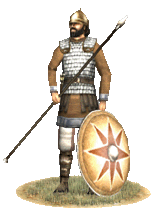 These heavy infantrymen use the old pointed Assyrian helmet and have iron scale corselets. Their weapons are the sword and spear. Their defence is the old fashioned Aspis shield faced with bronze. Their role on the battlefield is that of well drilled loose order infantry organized along the lines of Hellenistic Thureophoroi. These heavy infantrymen use the old pointed Assyrian helmet and have iron scale corselets. Their weapons are the sword and spear. Their defence is the old fashioned Aspis shield faced with bronze. Their role on the battlefield is that of well drilled loose order infantry organized along the lines of Hellenistic Thureophoroi.
Historically, the Hellenistic monarchies established after Alexander the Great’s conquest used the military settlement system widely, probably taking it over from the Persians. Native heavy infantry such as this was not well regarded by the Hellenic conquerors of Asian territories nor particularly trusted. Necessity, however, required troops to govern the kingdom and these troops were readily available and these considerations applied as well to the Parthian that would supplant the Seleucid Empire as masters of the lands where these heavy infantrymen were recruited. They came from the Aramean population of Babylonia, Syria and the Jews of Mesopotamia. While not playing the same significant role that Jews played in the Ptolemaic military system these men were present in significant numbers.
Qala'im Arabim (Arabian Slingers)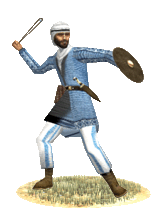 Slings are very easy and cheap to make, and yet they are a respectable weapon. It is for this reason that they are so prevalent among the poorer Arabian tribes. In battle, slingers are used as light skirmishers, troops with no armour or melee weapons but who rush forward against the enemy to pepper them with stones, only to flee when threatened. Slings are very easy and cheap to make, and yet they are a respectable weapon. It is for this reason that they are so prevalent among the poorer Arabian tribes. In battle, slingers are used as light skirmishers, troops with no armour or melee weapons but who rush forward against the enemy to pepper them with stones, only to flee when threatened.
Giusim Aravim 'im Garzenim (Red Sea Light Infantry)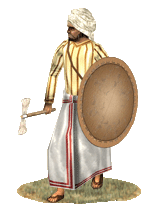 When the men of the Red Sea Coast are called to war they fight in a manner centuries old. Armed with the traditional balta harbiye, a double edged axe, and light wickerwork and leather shields, these men form a light and unruly levy. While they are not the toughest or most reliable troops on the field of battle they have been weathered and hardened by their inhospitable homeland, and their ability to survive, and thrive, in the desert climes of their native land is their greatest asset, even on the battlefield. When the men of the Red Sea Coast are called to war they fight in a manner centuries old. Armed with the traditional balta harbiye, a double edged axe, and light wickerwork and leather shields, these men form a light and unruly levy. While they are not the toughest or most reliable troops on the field of battle they have been weathered and hardened by their inhospitable homeland, and their ability to survive, and thrive, in the desert climes of their native land is their greatest asset, even on the battlefield.
Historically, the coast of the Red Sea was a comparatively populous and successful region, dotted with scattered towns and mountain settlements, despite widely spaced rivers and the lack of an agricultural infrastructure as old as in Saba to the South. These coastal peoples were a fairly hardy folk, used to more rugged territory and veterans of minor city conflicts, and wars that called them up as mercenaries or levies for larger armies. This background served them well in combat, and though not imbued with the same loyalty and religious fervor that the more traditional tribal allies and levies of the Sabaeans possessed, they were a strong shock infantry when their dedication was not overly taxed.
Dorkim Ezra'him (Sabaean Levy Spearmen)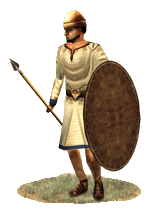 These urbanites are the core of Sabaean society and as such it is no surprise that they provide the bedrock of the Sabaean military machine. Armed with sturdy spears and protected by good quality helmets and hardy camel hide leather shields these men are far more capable than their lighter counterparts in tribal levies of holding the line of battle. Further, their religious fervor makes them more reliable in battle than many citizen forces. Still, their more sheltered urban existence makes them less able to bear the rigors of desert warfare than their nomadic fellows and their armament is not as heavy as comparable troops fielded by other states. A wise general will be mindful of both the strengths and weaknesses of these troops, the Sabaean will never recover their past splendor without their sweat and blood, but only when used in proper roles will their sacrifices be meaningful. These urbanites are the core of Sabaean society and as such it is no surprise that they provide the bedrock of the Sabaean military machine. Armed with sturdy spears and protected by good quality helmets and hardy camel hide leather shields these men are far more capable than their lighter counterparts in tribal levies of holding the line of battle. Further, their religious fervor makes them more reliable in battle than many citizen forces. Still, their more sheltered urban existence makes them less able to bear the rigors of desert warfare than their nomadic fellows and their armament is not as heavy as comparable troops fielded by other states. A wise general will be mindful of both the strengths and weaknesses of these troops, the Sabaean will never recover their past splendor without their sweat and blood, but only when used in proper roles will their sacrifices be meaningful.
Historically, the Sabaean urban population was the most substantial component of their impressive regular military. In Sabaean society, religion was among the most immediate concerns of the average citizen. Their years revolved around the Festival of Almaqah, while their days were first geared towards frequent sacrifices and offerings to him, administered by his all pervasive High Priesthood. Everywhere they might go, an agent of the High Priesthood could be encountered, and in everything they do, some aspect of their work can be seen, giving such citizens a massive psychological stake in their traditional religion. This simple dedication and familiarity made these citizens among the most loyal soldiers of the Sabaean infantry, beyond reproach and angered at the very prospect of foreign encroachment upon their childhood religion.
Erínamesh ana-Arabim (East Coast Levies)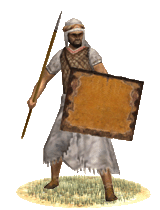 These raiders and pirates dominate the military stage of Eastern Arabia around Gerrha and historical Oman. In nature, they are light infantry equipped with padded armour worn over their dishdasha tunics, giving them some protection against arrow-fire. They carry shields made of wicker, osier and reed as well as that of hides and leather. They are swift, agile and their spears give them some edge over light cavalry. As they are more accustomed to the hot climate, these pirates and raiders make excellent desert warriors, albeit they are neither very disciplined or formally trained; Their loyalty is only a measure of the wages ordained by their paymaster. These raiders and pirates dominate the military stage of Eastern Arabia around Gerrha and historical Oman. In nature, they are light infantry equipped with padded armour worn over their dishdasha tunics, giving them some protection against arrow-fire. They carry shields made of wicker, osier and reed as well as that of hides and leather. They are swift, agile and their spears give them some edge over light cavalry. As they are more accustomed to the hot climate, these pirates and raiders make excellent desert warriors, albeit they are neither very disciplined or formally trained; Their loyalty is only a measure of the wages ordained by their paymaster.
Historically, the area around historical Gerrha and Oman, (Called "Mâzûn", by the subsequent Parthians and the Sassanians who came to dominate the political scene around the entire Persian Gulf) bolstered such warriors in an environment that demanded skill in naval trade and a tough bulwark adept in desert warfare. The natives of Gerrha were heavily influenced by Chaldaeans who were said to have built the city of Gerrha "entirely on blocks and slabs of salt" while the natives of Oman were more influenced by the Iranians over the strait of Hôrmûz. These Arabians were proficient in trading and in sea-faring, extending their influence as far as Dravidia in southern India, rivalling against the Nabataean Arabs to the west. It would be these Arabs who later became the stock of the later Lakhmid (Muntherid) dynasts, the powerful vassals of the Sassanians, marking a boundary between the sedentary and cosmopolitan Arabs and those who still adhered to nomadic principles.
Parashim Aravim Meguiasim (Arabian Light Cavalry)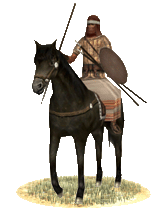 The majority of Saba’s cavalry arm was drawn not from her urban population, who were more often called on to serve as the center of the line of battle, but from her tribal allies. The tribes that provided these cavalry forces were generally nomadic in lifestyle and as such provided men who spent more time mounted than on foot, even if the mount was often a camel rather than a horse. In battle these men provide a highly skilled light cavalry contingent exceedingly capable in the roles of skirmishing, pursuit, and harassment. When coupled with the smaller contingent on medium cavalry fielded by Saba’s urban population they can also deliver a devastating charge to the flanks or rear of the enemy battle-line, but should not be expected to fulfill the role of shock cavalry on their own. The majority of Saba’s cavalry arm was drawn not from her urban population, who were more often called on to serve as the center of the line of battle, but from her tribal allies. The tribes that provided these cavalry forces were generally nomadic in lifestyle and as such provided men who spent more time mounted than on foot, even if the mount was often a camel rather than a horse. In battle these men provide a highly skilled light cavalry contingent exceedingly capable in the roles of skirmishing, pursuit, and harassment. When coupled with the smaller contingent on medium cavalry fielded by Saba’s urban population they can also deliver a devastating charge to the flanks or rear of the enemy battle-line, but should not be expected to fulfill the role of shock cavalry on their own.
Historically, the Arabs were a far-flung people, raised on the backs of camels and horses while crossing desert as traders or living the rugged life of the nomad. While they might generally have chosen the high perch of a camel for their travels, in battle, their horses were the prefered mount. Brought literally into a new saddle, they excelled in combat, well-served by the balance learned from riding a camel, and despite their light armor and armament, fought with skill - though not always with dedication.
Bnei Shevet Aravim (Arabian Light Infantry)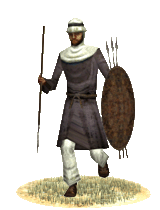 These lightly armed men are not much to look at, clad in simple attire and armed with the most rudimentary of weapons, a spear and shield, but they are far more capable soldiers than first glance would indicate. Exceedingly loyal to their Sabaean overlords they are much more reliable than their eastern levy counterparts and their experience in years of both tribal skirmishing and warfare on behalf of their Sabaean rulers has made them into warriors of surprising merit and skill. These lightly armed men are not much to look at, clad in simple attire and armed with the most rudimentary of weapons, a spear and shield, but they are far more capable soldiers than first glance would indicate. Exceedingly loyal to their Sabaean overlords they are much more reliable than their eastern levy counterparts and their experience in years of both tribal skirmishing and warfare on behalf of their Sabaean rulers has made them into warriors of surprising merit and skill.
Historically, the bulk of the Sabaean medium infantry line was levied from the Arab and Bedouin peoples under their direct or nominal rule, many of them serving as regulars, though most were recruited sporadically by agents of the Sabaean King. Their minor tribes and settlements had a history of loyalty to the Sabaeans, having fought alongside them and been under their rule to various extents for centuries, most of them coming to accept their religious practices ages ago. They were hardy veterans of numerous conflicts, with relatives who could in all likelihood say the same, generally invested in their ruler's cause and sympathetic to their often easy government.
|
 |
|
 |






















|